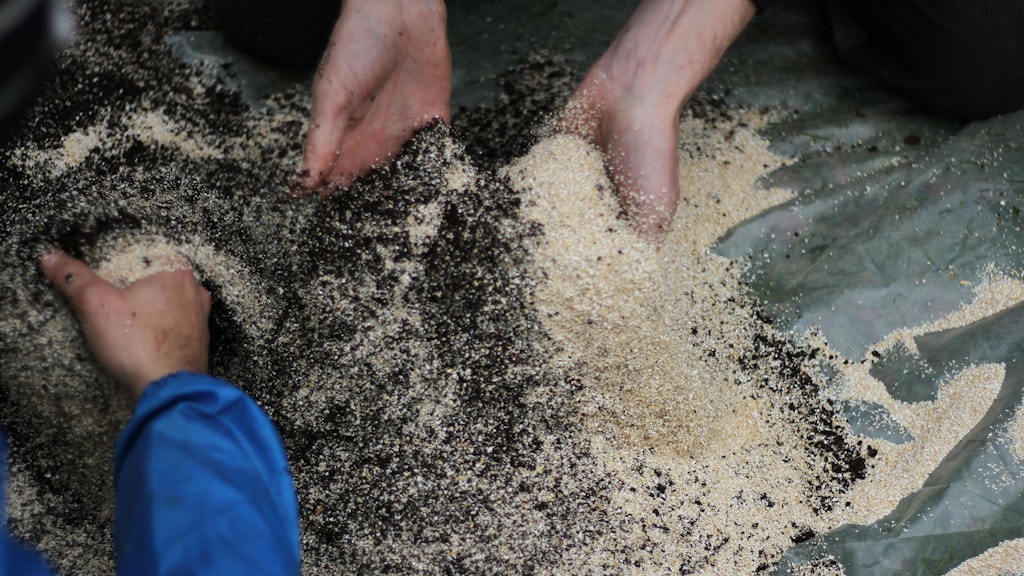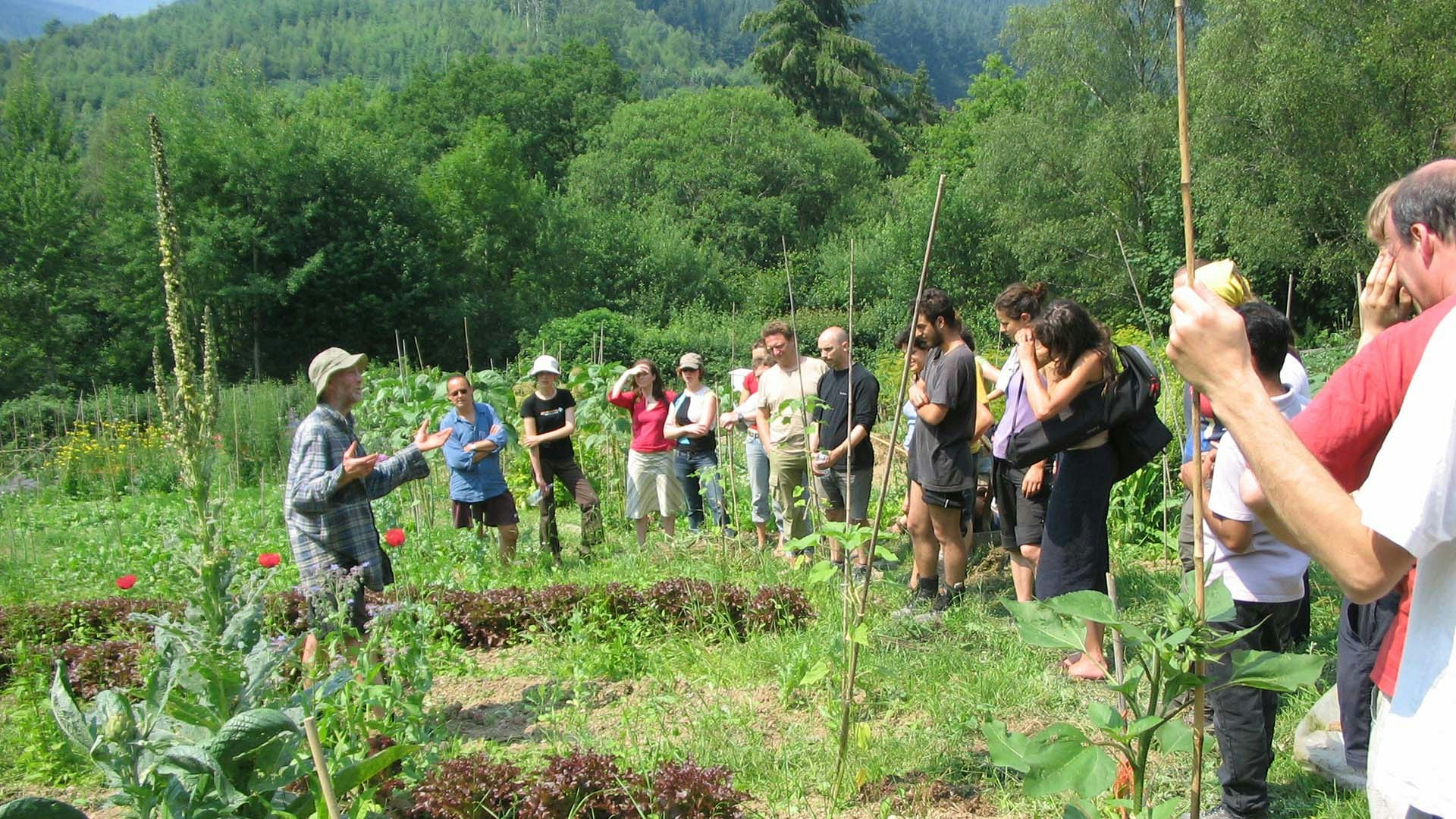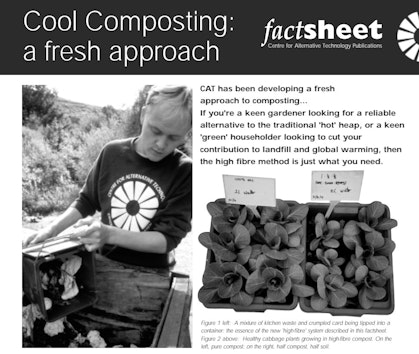Home Composting
Home composting is key to sustainable and organic gardening, as well as being the ideal way to recycle waste. CAT’s gardeners have tried out all sorts of composting methods over the years. It’s been vital for creating productive growing beds on our slate tip site.
Making your own compost saves you having to buy potting media, fertilisers and soil improvers. It therefore avoids the environmental impacts of processing and transporting these products – including the climate change impact of peat extraction.
Aim to make as much of your own compost and leaf mould as possible and add this to the soil at least once a year. Once a plot is established there is no need to dig the soil over. Simply add organic matter to planting holes, or as a mulch on top.
Easy composting
What a lot of households want is a compost bin or heap that doesn’t need much attention. However, a common complaint is that unattended compost turns into a sticky, smelly porridge. This tends to happen when you’re just adding stuff like kitchen scraps, green waste and grass clippings. Piled in together, they compress into a soft mass that squeezes out the air and stops the composting process.
You need to something else – something that will keep air spaces open in the heap, while also composting down. A simple solution is to add some types of paper and card, and make ‘high-fibre’ compost. This gives you a nice mix of nitrogen-rich green waste and fibrous, carbon-rich paper/card, and should lead to good compost.
Don’t add all paper waste, because paper and card that’s in decent condition should be recycled to save resources. Stuff at the top of this list is more suitable, because recycling collections don’t usually want stained or dirty paper. When you’ve got enough for your compost, the rest can be recycled.
- Tissues and kitchen towels
- Card or paper packaging with food stains
- Crumpled or balled paper, especially if dirty
- Toilet roll tubes
- Egg boxes (when no longer good enough to refill)
- Shredded paper packing
- Corrugated cardboard
- Cereal boxes and other food products
Avoid composting what is most suitable for recycling – such as newspapers and magazines, office paper and envelopes. Paper products that are waxed or lined with foil or plastic are not good for composting, but may also be difficult to recycle in some areas.
Starting high-fibre compost
Start with crumpled card/paper at the bottom of a container, about 20cm to 30cm deep. It’s great to add worm-rich compost from a previous batch or someone else’s compost. Then add the kitchen scraps and garden waste in roughly equal amounts to the paper and card. There’s no need to be too fussy, but make sure there’s plenty of air in the heap.
The composting process will begin over the next few months. If your compost heap is in the garden, beneficial creatures should turn up and multiply. Failing that, it’s possible to buy worms from a supplier of wormery systems. As you add waste at the top the zone of decomposer activity will move up with it. In a mature heap you’ll usually find a heaving layer of worms about 15cm below the surface, doing their decomposing work.
You should find that fine, crumbly brown compost accumulates at the bottom of the heap. If you have the space, you could fill one container and then start another one while the first finishes. Otherwise, choose a container that allows for a continuous process – removing the finished compost from below as you need it. If the finished compost is a bit wet, just leave it in the open for a few days to mature.
Traditional hot composting
The classic hot composting approach works well when you have a larger garden, and a lot of waste and time. In this type of ‘thermophilic’ (heat-loving) composting, the heat generated kills off most weed seeds and pathogens. Traditionally, you would layer cardboard and green waste in such a way that it heats up very quickly. It will reach 60-70°C in a matter of days, encouraging heat-loving microscopic organisms that will compost waste very quickly.
The heat is generated by bacteria and fungi reproducing quickly and consuming the easily available materials. After a week or so they either cook themselves to death or run out of air or easily accessible food. Therefore their activity declines and the temperature starts to drop. The process is restarted by turning or mixing the heap, adding water if needed. This might happen three or four times, with usable compost ready in about six weeks.
Hot composting bins
You can buy insulated compost bins that speed up the high fibre process by maintaining a high temperature. The bins include ventilation to keeps the mix aerated. Suitable carbon-rich ingredients include paper and card, dry leaves, and finely chipped woody waste.
Petra, one of CAT’s gardeners, has been using a 400 litre Aerobin here for about a year. She says it’s been great for putting all sorts of waste in, and it’s been working as intended, without problems. There have been no problems with rodents, the bin has plenty of worms in it, and it’s composting very well. Petra also gets good ‘compost tea’ liquid from a drain at the bottom.
Bokashi
This is a system for converting kitchen scraps into a nutrient-rich material.
The Bokashi method uses a specific blend of effective micro-organisms grown on bran and molasses. These are added to the kitchen scraps in small buckets, sealed tightly, and left for a few weeks to ferment. It can then be dug in to soil, or mixed in with compost. It usually relies on bought additives, but you can read about making a bokashi-like compost activator on our blog.

Compost without a garden
A wormery is self-contained composting system, and may be appropriate if you only have a yard or balcony. They use deliberately introduced worms to deal with small but regular amounts of rich food scraps. They often have a stacking design to give a few thin horizontal layers. The worms are at the top, the compost gathers in the middle, and ‘compost tea’ collects at the bottom. The juice is good for using on houseplants, and the compost for containers and window boxes.
They do need care and attention. For example you shouldn’t add too much food, or too little, or food that’s too acidic (like citrus or onion). There are likely to be ongoing costs, such as lime to counter acidity and protect the worms.
Further Information
CAT offers group visits and workshops. See also the nature and growing books in our online shop.
Related Questions
How do I deal with flies in my compost?If you compost kitchen waste there are invariably fruit-flies in the compost. These are like house-flies but much smaller, laying their eggs in decaying vegetable matter. They are quite harmless, and in fact their larvae, growing and feeding in the compost, are all part of the decomposer ecosystem.
The problem is an aesthetic one: in a closed container, flies hatch out, cannot escape and build up in large numbers. The result is a great cloud of flies in your face the next time the lid is removed.
Using a container with no lid (or part-lid) means that fruit-flies can leave as they hatch out, so do not accumulate and are much less noticeable. We have also found that a complete layer of grass clippings on the surface seems to reduce the number of flies to near zero. This is a promising method, since the flies are mainly a problem in the summer when grass clippings are available. It is simply a matter of timing your offerings to the heap so that you have clippings ready to spread on the surface over kitchen waste and paper.
You might also notice even smaller flies, rather like midges. These are fungus-gnats and also harmless. All the flies are food for the birds, who will swoop by and take them.
Into the Archive: Cool Composting
Study at CAT: Our Postgraduate Courses


Did you know we are a Charity?
If you have found our Free Information Service useful, why not read more about ways you can support CAT, or make a donation.
Email Sign Up
Keep up to date with all the latest activities, events and online resources by signing up to our emails and following us on social media. And if you'd like to get involved and support our work, we'd love to welcome you as a CAT member.

